WILD mushrooms have been used in cooking and Chinese traditional medicine for centuries, but commercial farming of the edible fungus is relatively recent. The first Australian mushroom grower was a Spanish migrant Raymond Mas, who experimented in a disused railway tunnel under Sydney’s Circular Quay in 1933.
From those dark beginnings, commercial production has mushroomed to the point where it is now the country’s fourth most valuable vegetable crop, after potatoes, tomatoes and leafy salad vegetables.
Inspired by Raymond’s success, other farmers started growing winter crops of mushrooms in open fields along the Hawkesbury River. They included Bert and Beryl Tolson, whose eldest son Rob recalls that frequent flooding during the 1950s washed away many of the vegetable crops they grew on the river flats at Cattai, near Windsor in Greater Sydney. Rob worked with Bert for a decade, before starting his own outdoor mushroom farm on higher ground at Vineyard.
“Back then, we got 10 shillings a pound for them, which would be $2.20/kg in today’s money,” says Rob. Allowing for inflation, that’s the equivalent of around $30/kg, more than double the price of mushrooms today at Sydney Markets. “They were expensive and weren’t terribly plentiful.”
As well as being at the mercy of the elements, producing mushrooms for canning was backbreaking work. It required crews of labourers to turn compost with shovels, hand-mould ridge beds, add spawn, cover it with soil, straw and hessian bags, then uncover the mushrooms when they were ready to be picked and sent to a cannery.
Determined to find a better way, Rob was part of the first wave of Australian growers to take their crops back indoors. Influenced by European designs, he started using large trays in growing rooms in 1967 that produced mushrooms of a more consistent quality and extended the season.
After a 1971 trip to some of the world’s major mushroom growing regions in Europe and the United States, Rob says he “came back with a head so full of ideas” it took seven years to implement them all.
“We needed to mechanise it to get quantity, throughput and get costs down,” he says. “I built filling machines, emptying machines, spawning and casing lines – a whole heap of stuff that I’d seen overseas – and then I went away in 1978 and found I’d got behind again.”
Almost 50 years later, the Tolson family operates what is thought to be Australia’s largest privately owned mushroom business, turning out more than 14 million kg a year.
The closed-loop business produces its own compost from agricultural waste material, grows mushrooms on it, then treats and recycles the compost which is sold for use in landscaping and soil mixes.
RELATED: Sustainable pig farm recycles food waste and captures methane
Key to the success of the enterprise is
White Prince Mushrooms, established in 1996 to manage the packing, marketing and distribution of mushrooms produced on the family farms owned and run by Rob and Norah’s three sons, which are all located in the area around Windsor in western Sydney.
Robert Tolson has Premier Mushrooms at Glossodia, Kevin owns Regal Mushrooms at Londonderry and David has Elf Mushrooms at Vineyard. Rob and Norah own Elf Farm Supplies at Mulgrave, which produces compost for all three farms and many more throughout NSW and Queensland.
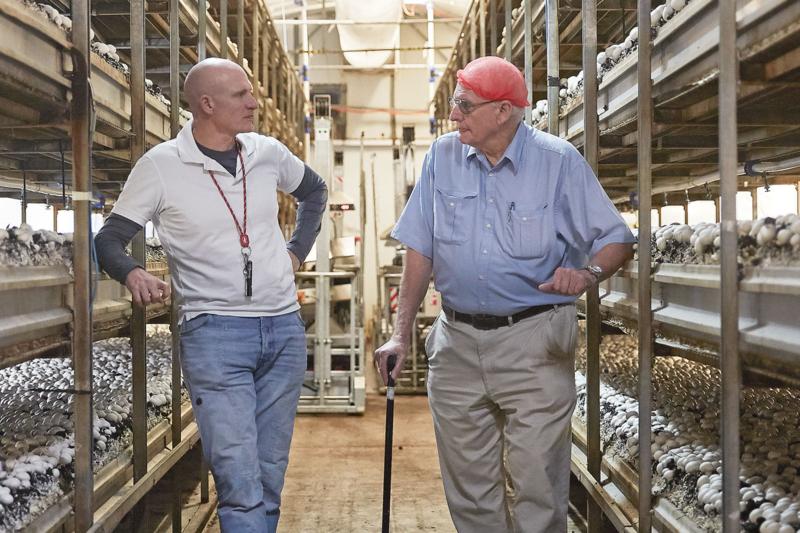
Kevin with his father Rob, who produces the organic mushroom compost used at all the family’s farms.
Rob and his sons are on the board of directors of White Prince, which has an independent chair and a separate management structure, led for the past 12 years by general manager Matthew Fensom.
White Prince sells the Tolsons’ whole and sliced white and brown mushrooms through stands at the Sydney Markets and directly to supermarket, food service operators and manufacturers. It also packages and markets asparagus, wild and exotic mushrooms and avocados.
Working in the business has become a rite of passage for the fourth generation. Robert’s son, Chris, is involved in managing Premier Mushrooms and works at Elf Farm Supplies. Kevin’s son, Clint, is undertaking an internship, spending a month at each site to learn about the business and the process of mushroom production from start to finish.
The prime purpose of White Prince is to achieve the best returns for the farms and the structure allows the directors to be more strategic, professional and consumer-focused, says Matthew Fensom.
“They’re all very different personalities and have their own businesses to worry about. Having a board and independent chairman takes away the family issues and keeps farm-related matters off the table.”
Cultivating the mushroom farming succession plan
Rob and Norah made it known early on that they didn’t want their three sons to be partners in one multi-generational farm. “They’d seen the dangers of that for families,” says David. “If someone’s not pulling their weight, in the structure we have, the only person it hurts is them.
Everyone gets the price for their product that it attains in the market. The model we have allows multiple people in the family – whether direct family members or even indirect – to flourish.”
.jpg) Rob Tolson passes wetted straw bales in the first phase of the mushroom compost process at his indoor facility at Mulgrave.
Rob Tolson passes wetted straw bales in the first phase of the mushroom compost process at his indoor facility at Mulgrave.
An example is Robert, who has the smallest farm but is focused on quality. “He would get a higher average price, but he’s a smaller producer,” says David. “That’s one of his strengths. When the market is over-supplied, he can still clear out the coolroom when others may be battling.”
A board, with monthly meetings and strategic planning, has made a massive difference to the business, giving everyone greater insight and confidence. “We’ve gone from when Dad started, and my oldest brother started in Dad’s farm, he was growing about 1 million kg per annum,” says David. “Now we’d be marketing about 14.5 million kg annually.”
The structure has helped ensure its longevity, says Rob. “We’re keen to have help, because we don’t know everything,” he says. They’re now interviewing for a new chair and several external directors to better position the $110 million business for the future.
Technology advancements to increase profits for mushroom farmers
Rather than achieving growth through acquiring smaller producers – the number of Australian growers has fallen from 140 in the 1980s to about 40 – David says it will be driven by
advances in technology. He plans to build a new farm on a 22ha site at Londonderry.
“You wouldn’t buy someone’s old Kingswood and try to race at Bathurst,” says David.
“Basically, all mushroom farms are as old as the Kingswood, and you wouldn’t do that if you’re going to take on the best in the world. It’s about designing and building the most efficient farms that will give us another 20-25 years at the cutting edge.”
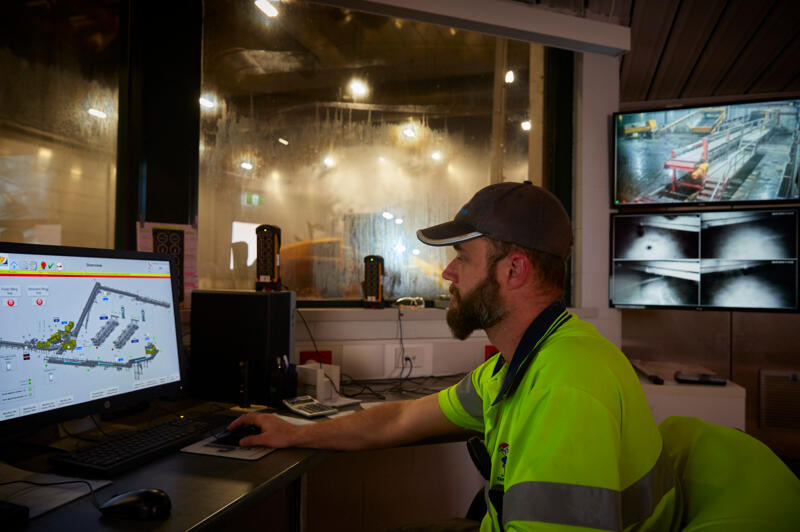 Manager, Shane Zaccazan checks operations inside the Phase 1 Control Room. The facility was recently rebuilt to incorporate odour mitigating technology.
Manager, Shane Zaccazan checks operations inside the Phase 1 Control Room. The facility was recently rebuilt to incorporate odour mitigating technology.
Technology has given them greater control over growing room temperature, carbon dioxide and humidity levels, allowing the shortening of cropping cycles and doubling production per square metre.
It’s also helped solve the problem of odour emissions from compost, which threatened the existence of the plant at Mulgrave – as housing estates came closer, complaints about the smell increased. First, the process was taken indoors, then Rob developed an inverted cone for aerating the compost.
Last year, a $55 million indoor composting facility was completed beside the existing plant. It uses conveyor belts, acid scrubbers and a biofilter of dampened Australian hardwood to eliminate odours and will double compost production to 3,000 tonnes per week.
“It’s state-of-the-art, probably the best in the world,” says Rob. “We’re very close to Windsor here, but we’ll probably be here for the next 50 years, because we’ve solved the problem and we’ve got a new compost yard that will have a fairly long life.”
The Tolsons are looking to technology to solve their other major challenge: the skyrocketing cost of production, despite little movement in wholesale and retail prices during the past decade.
RELATED: Thriving egg business adapts to consumer demand for cage-free
The price of electricity has doubled in the past five years but, even though the Tolsons have automated many processes, labour remains the greatest expense. Most of the 600 workers are employed as pickers and packers.
Robert and Kevin’s farms have been designed to allow pickers to use a motorised platform to move up and down between shelves and along rows. This allows the beds to be harvested up to six times a day. By contrast, the platforms on David’s farm – built by Rob in 1967 – can only move vertically, so pickers are limited to harvesting the beds twice a day.
.jpg) Pickers Usha Prasad and Natalie Tabone on the motorised platforms at Premier Mushrooms that allow them to move up, down and along the rows.
Pickers Usha Prasad and Natalie Tabone on the motorised platforms at Premier Mushrooms that allow them to move up, down and along the rows.
“The significance is that a mushroom doubles in size every 21 hours,” David says. “If you can leave a mushroom for an extra four hours, you’re getting an extra 15% yield. Being able to harvest over beds multiple times a day allows us to increase yield. We see a big part of our future will be in robotics and [machine] vision systems. It’s an exciting time to be building a new farm.”
The Tolsons have developed a three-month training program for pickers to teach the basics of sizing, grading and cutting stems, how to get faster and to avoid getting into bad habits.
“The job the pickers do is our reputation,” David says. “If they do a rough job, 24-48 hours post-harvest you’ll see that damage.” That’s particularly important now that 95% of mushrooms are sold fresh.
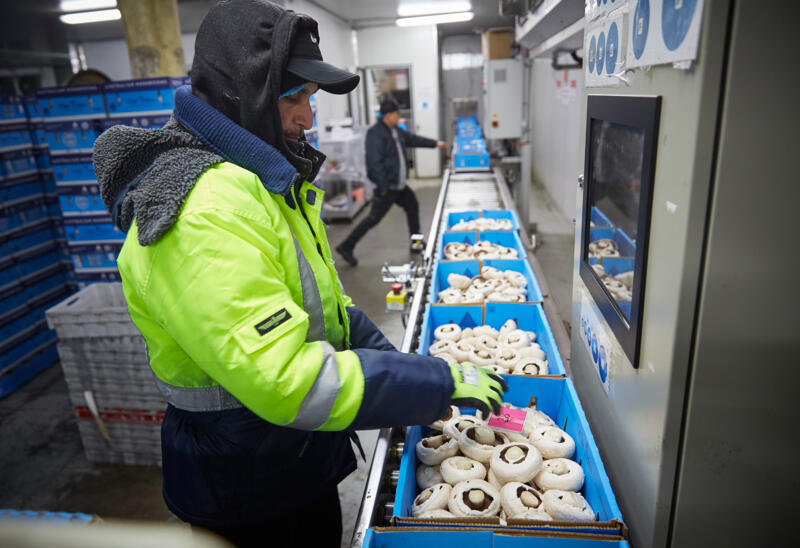 A conveyor belt at Regal Mushrooms sends boxes of flat mushrooms past Mandeep Singh so he can check the sizing and crating.
A conveyor belt at Regal Mushrooms sends boxes of flat mushrooms past Mandeep Singh so he can check the sizing and crating.
According to the
Australian Horticulture Statistics Handbook, mushrooms had a production value of $456.6 million in Australia in 2018. The handbook also says 69% of households bought mushrooms, averaging 287g in each shop. While the consumption of mushrooms has plateaued in recent years, Matthew Fensom says the increasing focus on the health benefits of plant-based foods is expected to boost the market.
“We have 15% of people who will never eat a mushroom and 85% who will,” he says.
“Research has found as people get older they prefer them and younger people don’t. As consumers become more into eating less meat, demand for mushrooms will naturally follow, because they’re a good source of protein.”
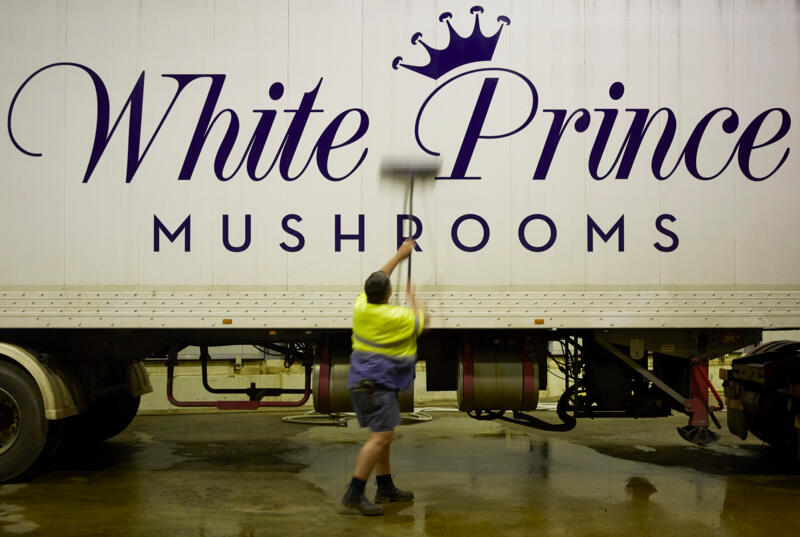 Transport driver Wayne Jones scrubs the outside of the White Prince Mushrooms truck before the finished compost is loaded and shipped from the Mulgrave plant.
Transport driver Wayne Jones scrubs the outside of the White Prince Mushrooms truck before the finished compost is loaded and shipped from the Mulgrave plant.
In the US, David says, mushroom consumption increased 10% in a year after mushrooms were blended into meat burgers to reduce fat and sodium in meals served in school canteens. “If other companies, such as McDonald’s, looked at reducing calories in burgers, it could increase demand greatly,” he says.
Six decades of mushroom farming growth
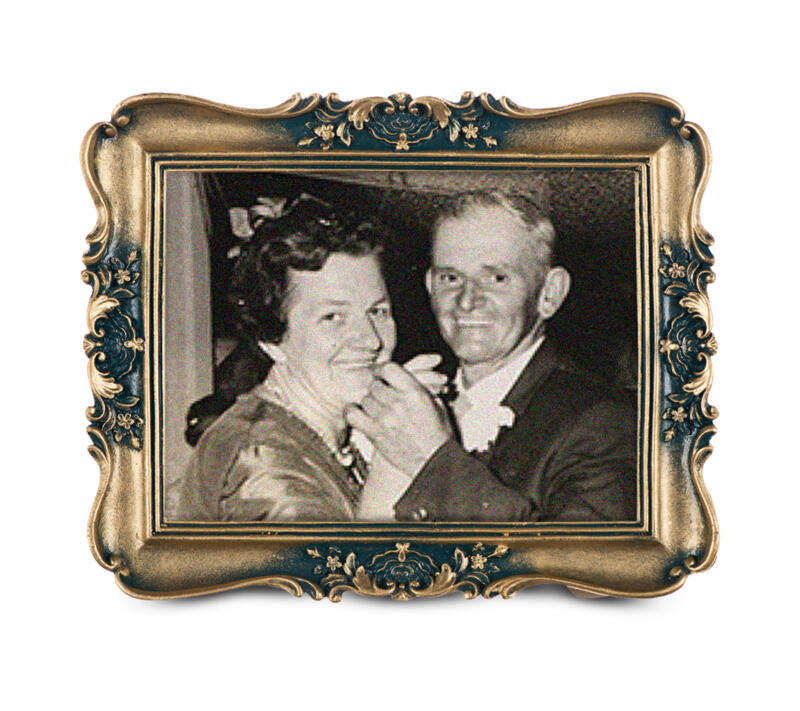
Beryl and Bert Tolson. Source: Supplied.
1956: Beryl and Bert Tolson and son Rob started producing mushrooms at Cattai.
1960s: Norah and Rob Tolson, launched Elf Mushrooms at Mulgrave, and built indoor growing rooms at Vineyard.
1990s: Rob and Norah’s three sons created White Prince Mushrooms to pack, market and distribute produce. Rob and Norah retained Elf Farm Supplies to produce compost.
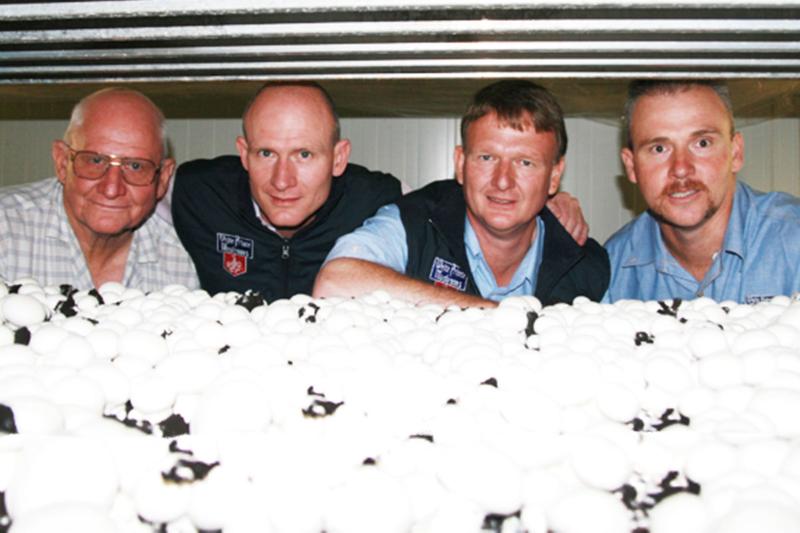 Rob Tolson with his sons Kevin, Robert and David – all three have joined him in the mushroom business.
Rob Tolson with his sons Kevin, Robert and David – all three have joined him in the mushroom business.
2009: White Price bought Metro Mushrooms at Sydney Markets and expanded
2018: Elf Farm Supplies completed a $55 million composting facility to double production to 3,000 tonnes per week, using biofilters to eliminate odours.
2019: David Tolson is planning a state-of-the-art farm at Londonderry. Robert and Kevin’s sons are part of the business.
Australian mushroom industry
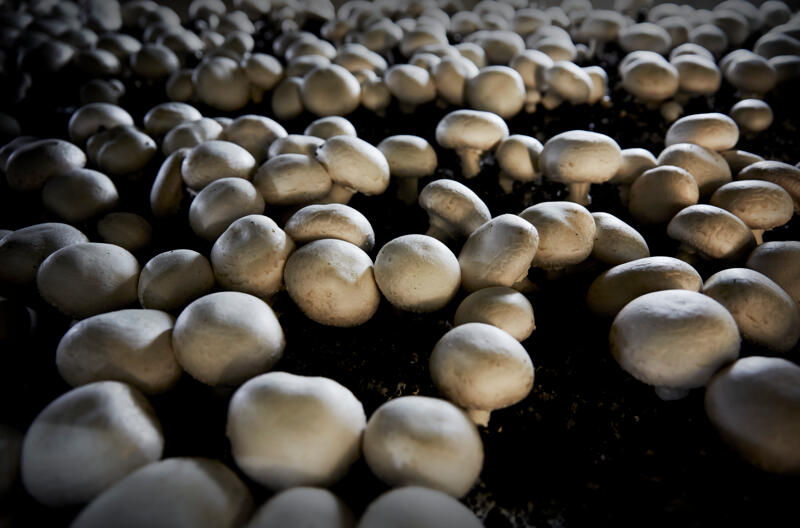 Mushrooms ripe for the picking.
Mushrooms ripe for the picking.
- 70,463 tonnes of fresh mushrooms produced in 2017/2018 in Australia. 22,054 tonnes produced in NSW.
- $456.6 million: value of the annual national mushroom production.
- 89 tonnes of mushrooms were exported, valued at $6.8 million. 25% of exports went to Fiji.
- 3,288 tonnes of mushrooms were imported into Australia, valued at $11.1 million. 82% of imports arrived from South Korea.
- 69% of Australian households buy mushrooms. Averaging 287g per shopping trip.
Source: Australian Horticulture Statistics Handbook 2017/18, Hort Innovation
Did you know?
In the 1980s, Australia had about 140 mushroom growers. By 2016, consolidation had reduced that to 42 growers.